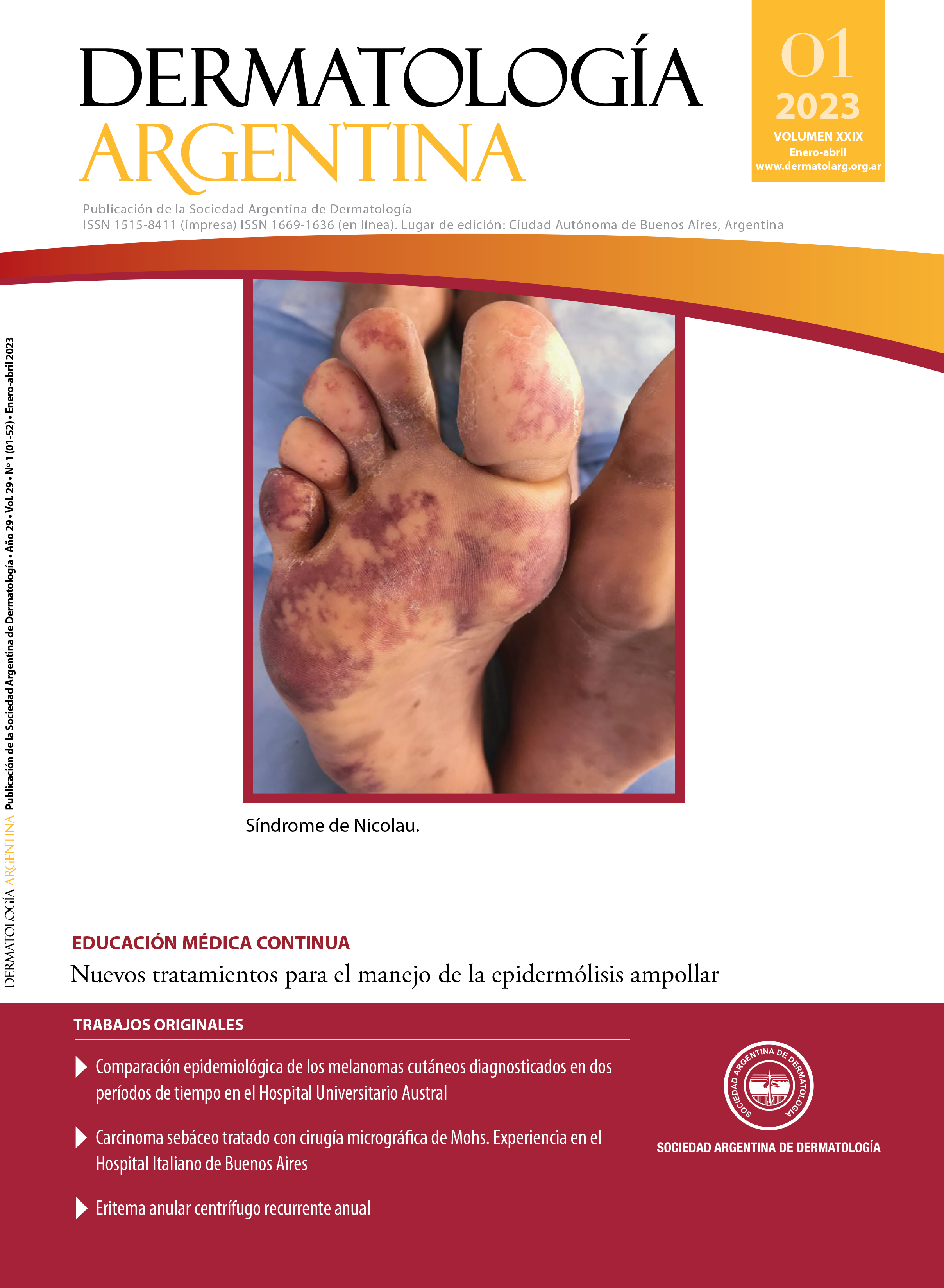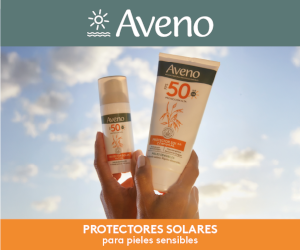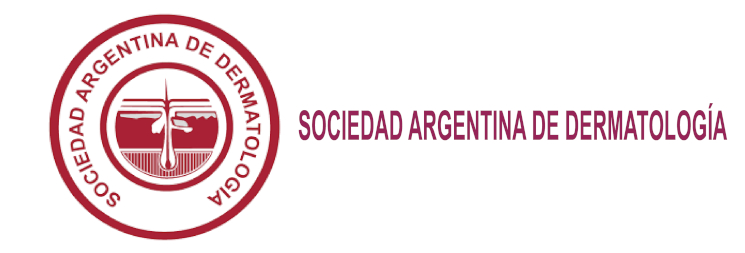Nuevos tratamientos para el manejo de la epidermólisis ampollar
DOI:
https://doi.org/10.47196/da.v29i1.2312Palabras clave:
epidermólisis ampollar, tratamientos, terapia génicaResumen
La epidermólisis ampollar es una familia de genodermatosis de baja prevalencia. Se caracteriza por la elevada fragilidad mecánica de los tejidos afectados, que da lugar a ampollas mucocutáneas, erosiones y ulceraciones de difícil tratamiento.
El amplio espectro fenotípico de la enfermedad va desde un compromiso
leve con afectación exclusivamente cutánea
hasta los fenotipos más severos, en los que pueden afectarse tanto la piel como las mucosas, lo que la convierte en una enfermedad multisistémica discapacitante e, incluso, mortal.
Si bien se la considera un paradigma de la biología de la piel, ya que su estudio permitió avances fundamentales en la comprensión del funcionamiento de la membrana basal, hasta el momento su manejo continúa como paliativo, ya que aún no hay ningún tratamiento dirigido hacia su fisiopatología. Sin embargo, en los últimos años, la investigación en la terapia génica ha tenido importantes avances hacia futuros tratamientos que podrían cambiar la vida de los pacientes.
El objetivo de este trabajo fue hacer una revisión de las novedades en los tratamientos de la epidermólisis ampollar y destacar los últimos descubrimientos.
Citas
I. Bardhan A, Bruckner-Tuderman L, Chapple ILC, Fine JD, et ál. Epidermolysis bullosa. Nat Rev Dis Primers. 2020;6:78-105.
II. Siañez-González C, Pezoa-Jares R, Salas-Alanís JC. Epidermólisis ampollosa congénita: revisión del tema. Actas Dermosifiliogr. 2009;100:842-856.
III. Uitto J, Pulkkinen L. Epidermolysis bullosa in Mexico. Int J Dermatol. 2000;39:433-435.
IV. Abahussein AA, al-Zayir AA, Mostafa WZ, Okoro AN. Epidermolysis bullosa in the Eastern Province of Saudi Arabia. Int J Dermatol. 1993;32:579-581.
V. Shinkuma S, Natsuga K, Nishie W, Shimizu H. Epidermolysis bullosa in Japan. Dermatol Clin. 2010;28:431-432.
VI. Fine JD. Epidemiology of inherited epidermolysis bullosa based on incidence and prevalence estimates from the National Epidermolysis Bullosa Registry. JAMA Dermatol. 2016;152:1231-1238.
VII. Monteavaro ML, Tosetto SJ, Schuler-Faccini L, Kiszewski AE. Inherited epidermolysis bullosa: update on the clinical and genetic aspects. An Bras Dermatol. 2020;95:551-569.
VIII. Bageta ML, Cella E, Martínez MF, Ledo GN, et ál. Características clínicas y epidemiológicas de los pacientes con epidermólisis ampollar congénita confirmada por estudio molecular. Estudio retrospectivo en un hospital pediátrico. Dermatol Argent. 2019;25:152-160.
IX. Has C, Bauer JW, Bodemer C, Bolling MC, et ál. Consensus reclassification of inherited epidermolysis bullosa and other disorders with skin fragility. Br J Dermatol. 2020;183:614-627.
X. Welponer T, Prodinger C, Pinon-Hofbauer J, Hintersteininger A, et ál. Clinical Perspectives of gene-targeted therapies for epidermolysis bullosa. Dermatol Ther. 2021;11:1175-1197.
XI. Hou PC, Wang HT, Abhee S, Tu WT, et ál. Investigational treatments for epidermolysis bullosa. Am J Clin Dermatol. 2021;22:801-817.
XII. Mavilio F, Pellegrini G, Ferrari S, Di Nunzio F, et ál. Correction of junctional epidermolysis bullosa by transplantation of genetically modified epidermal stem cells. Nat Med. 2006;12:1397-1402.
XIII. Hirsch T, Rothoeft T, Teig N, Bauer JW, et ál. Regeneration of the entire human epidermis using transgenic stem cells. Nature. 2017;551:327-332.
XIV. Eichstadt S, Barriga M, Ponakala A, Teng C, et ál. Phase 1/2a clinical trial of gene-corrected autologous cell therapy for recessive dystrophic epidermolysis bullosa [en linea]. JCI Insight 2019;4:e130554. Disponible en: <https://insight.jci.org/articles/view/130554> [Consultado julio 2022].
XV. Lwin SM, Syed F, Di WL, Kadiyirire T, et ál. Safety and early efficacy outcomes for lentiviral fibroblast gene therapy in recessive dystrophic epidermolysis bullosa [en línea] JCI Insight 2019;4:e126243. Disponible en: <https://insight.jci.org/articles/view/126243> [Consultado julio 2022].
XVI. Gurevich I, Agarwal P, Zhang P, Dolorito JA, et ál. In vivo topical gene therapy for recessive dystrophic epidermolysis bullosa: a phase 1 and 2 trial. Nat Med. 2022;28:780-788.
XVII. Hainzl S, Peking P, Kocher T, Murauer EM, et ál. COL7A1 Editing via CRISPR/Cas9 in Recessive Dystrophic Epidermolysis Bullosa. Mol Ther. 2017;25:2573-2584.
XVIII. Anzalone AV, Randolph PB, Davis JR, Sousa AA, et ál. Search-and-replace genome editing without double-strand breaks or donor DNA. Nature. 2019;576:149-157.
XIX. Umegaki-Arao N, Pasmooij AMG, Itoh M, Cerise JE, et ál. Induced pluripotent stem cells from human revertant keratinocytes for the treatment of epidermolysis bullosa. Sci Transl Med. 2014;6:1-10.
XX. Matsumura W, Fujita Y, Shinkuma S, Suzuki S, et ál. Cultured epidermal autografts from clinically revertant skin as a potential wound treatment for recessive dystrophic epidermolysis bullosa. J Invest Dermatol. 2019;139:2115-2124.
XXI. Gostyński A, Pasmooij AMG, Jonkman MF. Successful therapeutic transplantation of revertant skin in epidermolysis bullosa. J Am Acad Dermatol. 2014;70:98-101.
XXII. Goto M, Sawamura D, Nishie W, Sakai K, et ál. Targeted skipping of a single exon harboring a 4 premature termination codon mutation: implications and potential for gene correction therapy for selective dystrophic epidermolysis bullosa patients. J Invest Dermatol. 2006;126:2614-2620.
XXIII. Wagner JE, Ishida-Yamamoto A, McGrath JA, Hordinsky M, et ál. Bone Marrow Transplantation for Recessive Dystrophic Epidermolysis Bullosa. N Engl J Med. 2010;363:629-639.
XXIV. Conget P, Rodriguez F, Kramer S, Allers C, et ál. Replenishment of type VII collagen and re-epithelialization of chronically ulcerated skin after intradermal administration of allogeneic mesenchymal stromal cells in two patients with recessive dystrophic epidermolysis bullosa. Cytotherapy. 2010;429-431.
XXV. Woodley DT, Keene DR, Atha T, Huang Y, et ál. Injection of recombinant human type VII collagen restores collagen function in dystrophic epidermolysis bullosa. Nat Med. 2004;10:693-695.
XXVI. Remington J, Wang X, Hou Y, Zhou H, et ál. Injection of recombinant human type VII collagen corrects the disease phenotype in a murine model of dystrophic epidermolysis bullosa. Mol Ther. 2009;17:26-33.
XXVII. Cogan J, Weinstein J, Wang X, Hou Y, et ál. Aminoglycosides restore full-length type VII collagen by overcoming premature termination codons: therapeutic implications for dystrophic epidermolysis bullosa. Mol Ther. 2014;22:1741-1752.
XXVIII. Woodley DT, Cogan J, Hou Y, Lyu C, et ál. Gentamicin induces functional type VII collagen in recessive dystrophic epidermolysis bullosa patients. J Clin Invest. 2017;127:3028-3038.
XXIX. Li Y, Shen J, Liang J, Zheng L, et ál. Gentamicin induces COL17A1 nonsense mutation readthrough in junctional epidermolysis bullosa. [en línea] J Dermatol. 2020;47:e82-83. [Consultado julio 2022].
Descargas
Publicado
Número
Sección
Licencia
Derechos de autor 2023 a nombre de los autores. Derechos de reproducción: Sociedad Argentina de Dermatología

Esta obra está bajo una licencia internacional Creative Commons Atribución-NoComercial-SinDerivadas 4.0.
El/los autor/es tranfieren todos los derechos de autor del manuscrito arriba mencionado a Dermatología Argentina en el caso de que el trabajo sea publicado. El/los autor/es declaran que el artículo es original, que no infringe ningún derecho de propiedad intelectual u otros derechos de terceros, que no se encuentra bajo consideración de otra revista y que no ha sido previamente publicado.
Le solicitamos haga click aquí para imprimir, firmar y enviar por correo postal la transferencia de los derechos de autor













